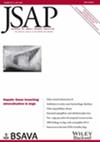Clinical manifestations, endoscopic findings and outcomes of tonsillar fossa foreign bodies in dogs: seven cases (2020-2023)
Abstract
Objectives
Clinical presentation and outcomes of dogs with tonsillar foreign bodies are not described in the literature. The objective of this case series is to describe the presence, clinical manifestations, endoscopic findings and outcomes of foreign bodies in the palatine tonsillar fossa of dogs.
Materials and Methods
Medical records of dogs in which tonsillar fossa foreign bodies were removed by endoscopy between 2020 and 2023 at a referral centre were reviewed. Dogs were included if complete medical records were available.
Results
Seven dogs were included. Among all clinical signs reported, acute onset of throat clearing occurred in all dogs. Palatine tonsil enlargement and protrusion from the tonsillar fossa were observed in four of seven dogs. Foreign bodies were removed under endoscopic guidance in all dogs; a vegetal foreign body was found in all but one dog (6/7). Complete resolution of clinical signs was reported in the five dogs for which follow-up information was available.
Clinical Significance
The tonsillar fossa is a rare but possible location for foreign bodies in dogs and should be explored even in the absence of macroscopic lesions of the tonsils, since some dogs could have a normal palatine tonsil appearance. Acute throat clearing should raise the suspicion of tonsillar fossa foreign bodies. The prognosis appears good after removal.

 求助内容:
求助内容: 应助结果提醒方式:
应助结果提醒方式:


